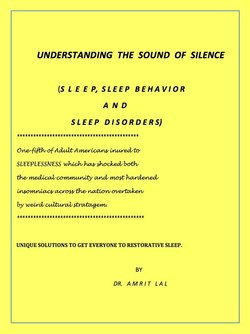Читать книгу Understanding the Language of Silence - Sleep, Sleep Behavior and Sleep Disorders - Dr. Amrit Lal - Страница 10
На сайте Литреса книга снята с продажи.
A PERIOD OF RELATIVE QUIESCENCE
ОглавлениеWhile a lot is now known about sleep, many unchartered areas still remain awaiting to be explored by sleep scientists. This realization led American Medical Association in 1996 to recognize sleep medicine as a specialty and interest in sleep science gradually began to emerge in the medical community.
Sleep science is truly a multi-disciplinary science forming a rainbow of rich hues from the fields of physiology, psychiatry, psychology, cardiology, bio-physics and the list goes on. A slew of research to unravel a number of hidden aspects of sleep in world’s sleep laboratories has now become a high decibel area of research. At least, what is now known about sleep are a number of variations such as it is a period of somewhat ‘quiescence’ when all activity, normally undertaken when we are awake, ceases; and there is a reduced responsiveness to external stimuli. While asleep one is unable to work for living or otherwise, have training or education or do anything involving cognition or take care of young or be able to procreate. Animals cannot forage for food or avoid dangers of predation. Urine gets more concentrated and gastric functions also go down during sleep.
Sleep researchers Kleitman and Aserinsky in 1953 hypothesized that sleep is our natural or passive state of existence and “we must be stimulated into wakefulness by sensory experiences or by muscular activity or else without such stimulation we stay asleep like a stone.” But many other sleep researchers do not align with this concept of sleep as a completely “passive” state and view it as an active state – the very name REM (Rapid Eye Movement – an important phase of sleep) testifies such an activity. German psycho-analyst, Sigmund Freud, in Interpretation of Dreams in 1900 noted that muscles paralyze during sleep that hinder the sleep from acting out of their dreams (barring a few exceptions of sleep-walking or somnambulism.)
Some sleep scientists describe sleep as an interruption of wakefulness. Romanticism of the middle ages and early 20th century has provided many poetical rich hues of sleep. The English bard, William Shakespeare, called sleep “the death of each day’s life” while Homer in Iliad said of “sleep and his twin brother death.” Samuel Johnson, saw sleep as an “irresistible stupefaction” – the absence of overt objective behavior of which a waking individual is capable of. Another writer, Miguel de Cervantes of Don Quixote fame, eulogized sleep in these words: “Blessings light on him who first invented sleep! It covers man all over, body and mind, like a cloak; it is meat to the hungry, drink to the thirsty, heat to the cold, and cold to the hot; it is a coin that can purchase all things; the balance that makes the shepherd equal with the king, the fool with the wise man.” And to quote Ernest Hemingway, “I love sleep. My life has a tendency to fall apart when I’m awake, you know? Cervantes’s Sancho song praised sleep, “the food that cures all hunger, the water that quenches all thirst, the fire that warms the cold, the cold that cools the heart…the balancing weight that levels the shepherd with the king, the simple with the wise.
